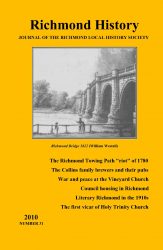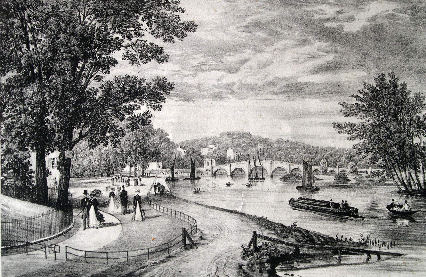 The common man fights back
The common man fights back
 Most Thameside historians research the life and times of the rich and famous – they were the ones who left diaries, accounts and press cuttings to ensure that they would be remembered – but the articles in Richmond History 31 showed just how much we can learn about the less privileged, if we dig a little deeper.
Most Thameside historians research the life and times of the rich and famous – they were the ones who left diaries, accounts and press cuttings to ensure that they would be remembered – but the articles in Richmond History 31 showed just how much we can learn about the less privileged, if we dig a little deeper.
Peter Flower, for instance, not only rescued a First World War memorial from oblivion at the Vineyard Congregational Church, but also the stories of those recorded on it. Thanks to him we now know about their families and where they lived. ‘We will remember them.’
John Cloake did much the same for our ancient pubs, rescuing their histories and identifying their sites, many of them surely patronised by those WWI heroes. A few are still where they were founded, though often with different names.
In Richmond, the Prince’s Head, the Old Ship, the Cricketers, the Roebuck, the Waterman’s Arms, the White Hart; in Petersham, the Dysart Arms; in Ham, the New Inn. Others have been superseded by supermarkets, cinemas and offices, and restaurants – in Kew, the King’s Arms; in Richmond, the Talbot and the old coaching inn of the Greyhound, its entrance still easily identified today.
Who would have thought, for instance, http://healthsavy.com/product/ativan/ that genteel Richmond would have been a pioneer in the provision of council housing? But Manor Grove was one of the first estates in the country thanks to one determined councillor, William Thompson, as Roberta Turner showed. Perhaps it should be declared a Conservation Area?
Judith Church and Michael Lee also sought out stories of men distinguished in their time and now in danger of oblivion – Evan Hopkins, the first vicar of Holy Trinity, and Douglas Sladen, a literary lion of his day.
Most unexpected of all was Edward Casaubon’s discovery that 18th-century Richmond was home to one of the most unlikely riots, one orchestrated by a coalition of its richest and poorest residents, neither of whom could stomach the creation of the towpath. Their protest failed, but not for lack of vigour – and, unlike today, the riot was apparently conducted without the inflammatory effect of alcohol.
A free index to issues 1 to 38 of Richmond History is now available online.


